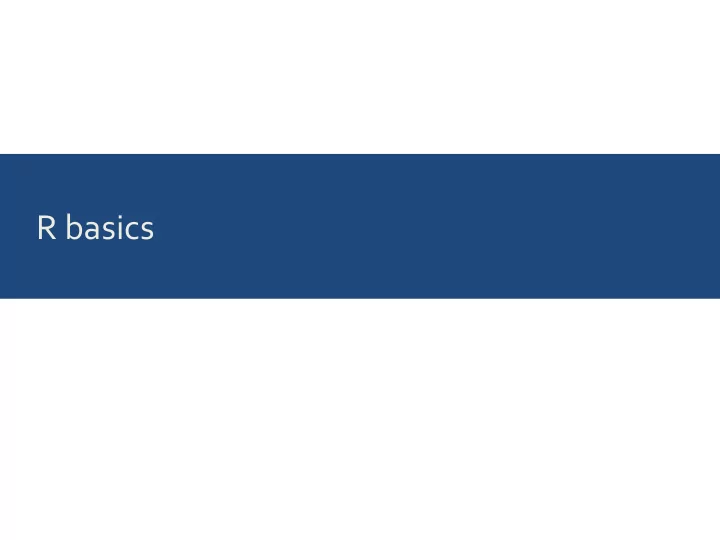

R basics
Assignments, numbers, vectors Assign number 5 to variable x > x <- 5 > x [1] 5 Calculate 5*x 2 +7 > 5*x^2+7 [1] 132 Create vector, assign > y <- c(1, 2, 3, 4, 5) to variable y > y [1] 1 2 3 4 5 Multiply each element > x*y in y with the number in x [1] 5 10 15 20 25
Strings A string contains text: > name <- "Claus Wilke" > name [1] "Claus Wilke" A vector of strings: > animals <- c("cat", "mouse", "mouse", "cat", "rabbit") > animals [1] "cat" "mouse" "mouse" "cat" "rabbit"
Factors Factors keep track of distinct categories (levels) in a vector: > animals [1] "cat" "mouse" "mouse" "cat" "rabbit” > factor(animals) [1] cat mouse mouse cat rabbit Levels: cat mouse rabbit
Data frames We use data frames to store data sets with multiple variables: > pets <- data.frame( family = c(1, 2, 3, 4, 5), pet = animals ) > pets family pet 1 1 cat 2 2 mouse 3 3 mouse 4 4 cat
Data frames We access individual columns in a data frame with $ + the column name: > pets$family [1] 1 2 3 4 5 > pets$pet [1] cat mouse mouse cat rabbit Levels: cat mouse rabbit
Data frames R has many built-in data frames: > cars speed dist 1 4 2 2 4 10 3 7 4 4 7 22 5 8 16 6 9 10 7 10 18 8 10 26 9 10 34 10 11 17
Data frames The head() function shows the first few lines of a data frame: > head(cars) speed dist 1 4 2 2 4 10 3 7 4 4 7 22 5 8 16 6 9 10 >
Hypothesis testing: a quick review
H 0 and H A : Null and alternative hypothesis H 0 : Null hypothesis, assumption that the data show no signal, that nothing has happened. H A : Alternative hypothesis, opposite of H 0 , assumption that something has happened.
The P value tells us how unexpected the data are P value: Probability to observe the given data under the assumption that H 0 is true We generally reject H 0 if P < 0.05 We never accept H A
t test: Do two groups of numerical measurements have the same mean?
Correlation: Do two numerical variables have a relationship with each other?
Multivariate regression: Which predictors have an effect on the response variable? Example:
Recommend
More recommend